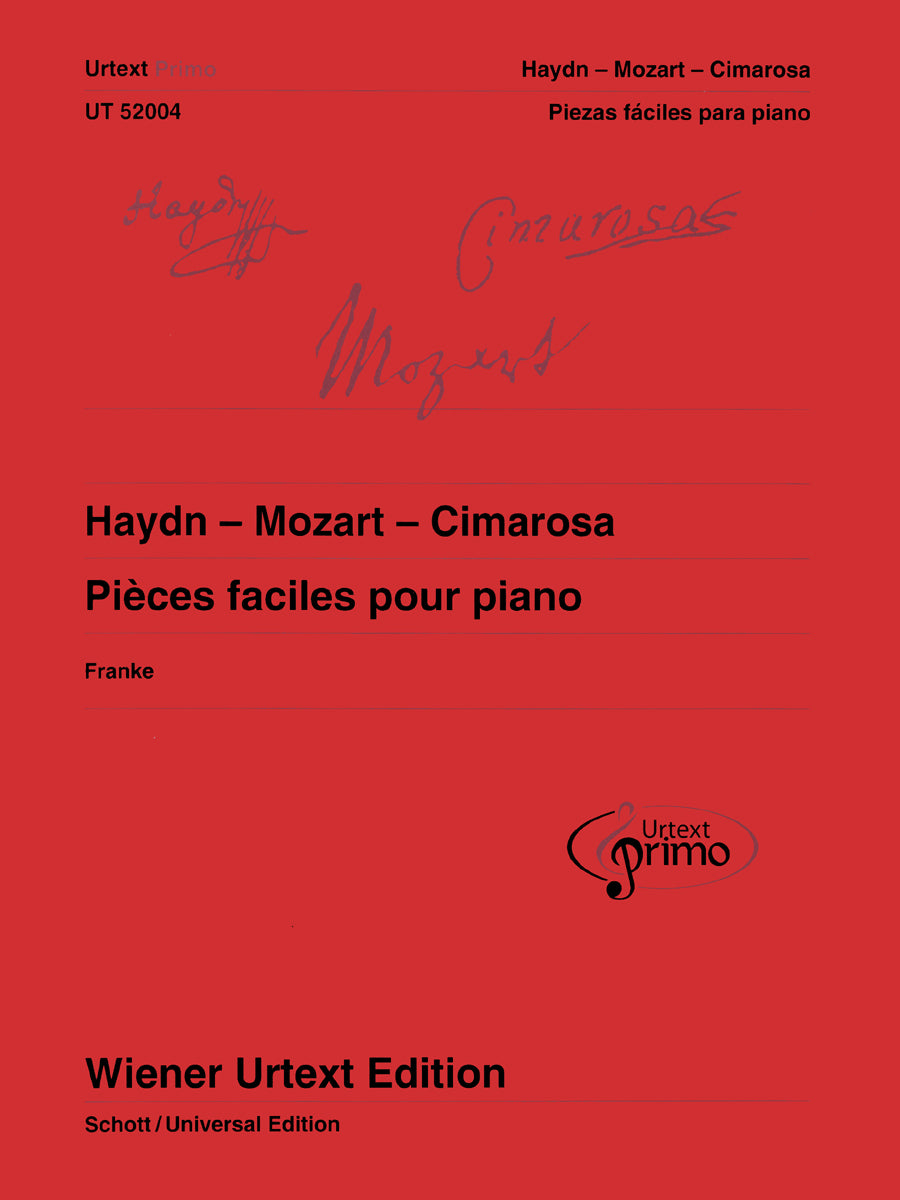Haydn-Mozart-Cimarosa: Easy Piano Pieces with Practice Tips
In stock and typically ships within 1 business day.
- Composers: Wolfgang Amadeus Mozart (1756-1791), Joseph Haydn (1732-1809), Domenico Cimarosa (1749-1801)
- Instrumentation: Piano
- ISMN:
- Size: 9.1 x 11.9 inches
- Urtext / Critical Edition
Description
With this Urtext Primo series, the Wiener Urtext Edition wants to close the gap arising at the point of transition to additional lessons after having studied a piano method. Works by three different composers are selected for each volume of the Urtext Primo series, with the aim of offering piano pupils (or even adults who want to resume piano playing) a wide range of repertoire pieces on the basis of which they can enhance their technical and musical skills. The pieces' range of levels of difficulty is relatively narrow so that the volume can be used continuously over a period of about two years. This is what distinguishes the Urtext Primo approach from almost all common anthologies. The selected repertoire takes into account not only pieces of the classic canon of lessons, but also lesser known works which are in no way of less importance for piano lessons.
Contents:
- Joseph Haydn (1732-1809): Rondo in Es (Hob. I:85/I)
- Joseph Haydn (1732-1809): Menuetto in B (Hob. I:85/III)
- Haydn Joseph: Adagio in F (Hob. XVII:9)
- Joseph Haydn (1732-1809): Allegro in B (Hob. XXVIII:8/I)
- Haydn Joseph: Andante in A (Hob. I:53/II)
- Haydn Joseph: Sonata in G (Hob. XVI:8)
- Haydn Joseph: Menuet in A (Hob.XV I:26/II)
- Haydn Joseph: Sonata in F (Hob. XVI:9)
- Mozart Wolfgang Amadeus: Allegro in F (K. 15a)
- Mozart Wolfgang Amadeus: Presto in B (K. 15ll)
- Mozart Wolfgang Amadeus: Pimpinella (K. 33B)
- Mozart Wolfgang Amadeus: Thema in Es (K. 236)
- Mozart Wolfgang Amadeus: Andante in G (K. 545/II)
- Mozart Wolfgang Amadeus: Adagio in C (K. 356)
- Mozart Wolfgang Amadeus: Trauermarsch in c (K. 453a)
- Domenico Cimarosa (1749 -1801): Sonata in D (C. 8)
- Domenico Cimarosa (1749 -1801): Sonata in d (C. 9)
- Domenico Cimarosa (1749 -1801): Sonata in d (C. 17)
- Domenico Cimarosa (1749 -1801): Sonata in A (C. 21)
- Domenico Cimarosa (1749 -1801): Sonata in C (C. 50)
- Domenico Cimarosa (1749 -1801): Sonata in g (C. 33)
- Domenico Cimarosa (1749 -1801): Sonata in c (C. 66)
- Domenico Cimarosa (1749 -1801): Sonata in Es (C. 67)
- Domenico Cimarosa (1749 -1801): Sonata in c (C. 68)
- Domenico Cimarosa (1749 -1801): Sonata in a (C. 2)
Publishers use a lot of words to describe what they sell, and we know it can be confusing. We've tried to be as clear as possible to make sure you get exactly what you are looking for. Below are descriptions of the terms that we use to describe the various formats that music often comes in.
Choral Score
A score for vocalists that only contains the vocal lines. The instrumental parts are not there for reference. Generally, cheaper than a vocal score and requires multiple copies for purchase.
Facsimile
Reproductions of the original hand-written scores from the composer.
Full Score
For ensemble music, this indicates that the edition contains all parts on a single system (there are not separate parts for each player). In larger ensembles, this is for the conductor.
Hardcover
Hardbound. Generally either linen-covered or half-leather.
Orchestral Parts
Similar to a wind set, this is a collection of parts. In the case of strings, the numbers listed are the number of copies included, though generally these are available individually (often with minimum quantities required).
Paperback
When publishers offer multiple bindings (e.g. hardcover) or study scores, this is the "standard" version. If you're planning to play the music, this is probably what you want.
Performance / Playing Score
A score of the music containing all parts on one system, intended for players to share. There are not separate parts for each player.
Set of Parts
For ensemble music, this indicates that there are separate individual parts for each player.
Solo Part with Piano Reduction
For solo pieces with orchestra, this is a version that contains a piano reduction of the orchestra parts. For piano pieces, two copies are typically needed for performance.
Study Score
A small (think choral size) copy of the complete score meant for studying, and not playing. They make great add-ons when learning concertos and small chamber works.
Vocal Score
A score prepared for vocalists that includes the piano/organ part or a reduction of the instrumental parts.
Wind Set
For orchestral music, this is a collection of wind and percussion parts. The specific quantities of each instrument are notated.
With Audio
In addition to the printed music, the edition contains recordings of the pieces. This may be an included CD, or access to files on the internet.
With / Without Fingering (Markings)
Some publishers prepare two copies - a pure Urtext edition that includes no fingering (or bowing) suggestions and a lightly edited version that includes a minimal number of editorial markings.



